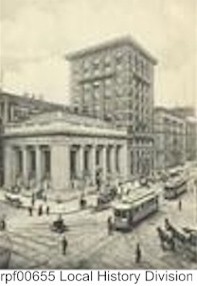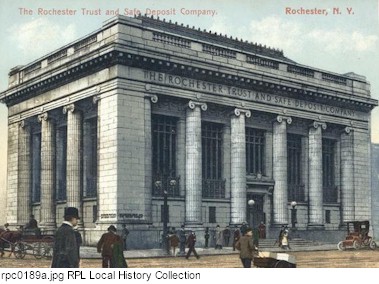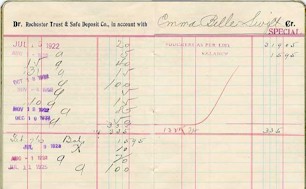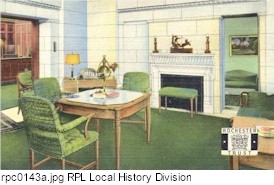
Rochester Trust & Safe Deposit Company

In 1868 the Safe Deposit Company of the City of Rochester was incorporated. This was the first organization of its type in the city. Its sole concern was safekeeping. The company opened for business in 1869 inside the Monroe County Savings Bank building on State Street. In 1884 they changed their name to Rochester Trust and Safe Deposit Company when they decided to expand their services to include general banking, specializing in trusts. Incidentally, this was also the first trust company established in the city. They re-opened for business on April 12, 1888 in their new six-story brown stone office building, built for them on Exchange Street by the architectural firm Warner & Brockett. Their business increased over the years and they soon found need for yet another building.
The 1888 Building |
The 1906 Building |
 |
The company appointed a building committee to work out the details of a new structure. Smith’s Arcade, at the southwest corner of Main and Exchange, was located at Rochester’s busiest intersection, the Four Corners. The Rochester Trust and Safe Deposit Co. purchased Smith’s Arcade in 1903 and had it razed to make way for the construction of their new bank at this ideal central location.
The firm of York & Sawyer was hired for the architectural work while A. Friedrich & Sons were hired as the contractors. The building was constructed of marble and Milford granite and was labeled a modern Greek design. Many people claimed the building was similar to the Temple of Athena Nike (also called the Temple of Victory) in Athens, Greece. It was completed in 1905 and it opened for business in 1906.
|
|
A view of the bank entrance from the exterior in 1938 and a view of the bank’s interior in 1938.
A pamphlet distributed by the bank entitled "Rochester Trust and Safe Deposit Company" was released in 1906. It outlined the company’s services, banking terms and guidelines, its history and its new "unexcelled facilities." Its description of the lobby stated that "The main room is vaulted over, roof high, the architecture being of Ionic design. It is finished in marble, and decorated in green and gold." Of utmost concern to the bank’s customers, however, would be the security of their money and holdings. The pamphlet detailed the vault security as follows:
|
In addition to the regular bank vault, there is a safe deposit vault arranged for four thousand safe deposit boxes, and both the bank and deposit vaults are equipped with every appliance that modern engineering skill can devise to render them impregnable to burglars, mobs or fire. They are constructed entirely of undrillable chrome steel, and are surrounded by a wall of concrete in which is imbedded a grill of connected steel rods. Outside this wall of steel and concrete is a passage for the watchman, leaving an open space entirely around the vaults. By an ingenious arrangement of mirrors, the watchman standing in front of the vaults is able to see the entire length of the passage around them… or he may walk through this passage, and at any point can see, by the reflections in the mirrors, the entire length of it. As a final protection, these vaults are furnished with appliances which notify the Police Department if the vaults are tampered with… In case of fire or riot, this whole portion of the basement can be flooded with water…[The vaults provide] an absolutely safe and private depository for valuable papers and documents, and also storage for silver, jewels and other valuable property. |
|
 |
The cover and interior
pages of a bank book from the 1920s.
In 1920 another bank, the Fidelity Trust Company, merged into the Rochester Trust and Safe Deposit Company. The roof was raised on the 1906 structure to make room for another story. Additional space was soon needed though. In December of 1929 a six-story addition on Exchange Street, at the rear of the building, was completed. Also constructed of Milford granite, this addition blended in well with the 1906 structure. The firm of Gordon & Kaelber designed the addition. The contractors were Stewart & Bennett.
|
The circa 1920 addition |
The 1929 addition |
The Rochester Trust and Safe Deposit Company was also known for its Women’s Department. A separate room was kept in the bank for its female customers. According to the bank’s 1906 pamphlet:
| The wisdom of a woman keeping her separate bank account for household purposes, or as part of her separate estate, is demonstrated by the fact that it means to her independence, experience in business methods, practical book-keeping, and full control of the financial part of her household, as well as interest upon whatever balance such account shows. More than that, when her account is kept with [us], it means that she has a friend in the company, which gives her the opportunity to avail herself of its experiences and facilities, and the advice of its legal department, in matters pertaining to property, and she may consider it her friend in every business relation. |
 |
 |
Two views of the Women’s Department in the Rochester Trust & Safe Deposit Co.’s building.
The Rochester Trust and Safe Deposit Company merged with Lincoln Alliance Bank and Trust Company to form a new bank in 1945, which became known as Lincoln Rochester Trust Company. The new bank (which subsequently changed names several more times) continued to use the facilities on the southwest corner of Main and Exchange Streets. However, in the 1960s the bank was razed to make way for a modern office tower, named the Four Corners Building.

A check from the bank,
which probably dates to the 1920s.
Send comments to Webmaster
Copyright Monroe County (NY) Library System
115 South Ave., Rochester, NY 14604